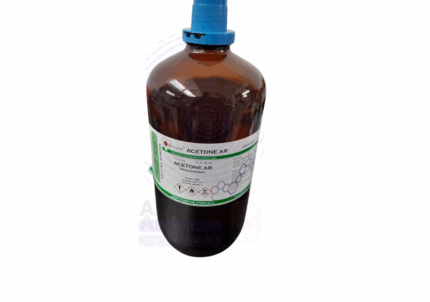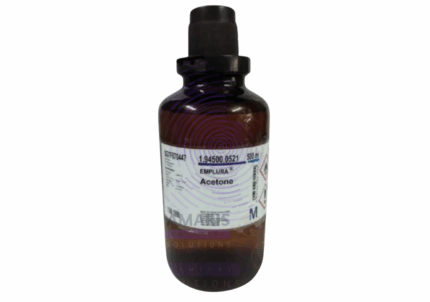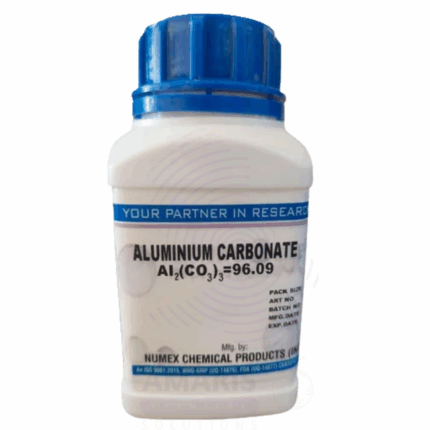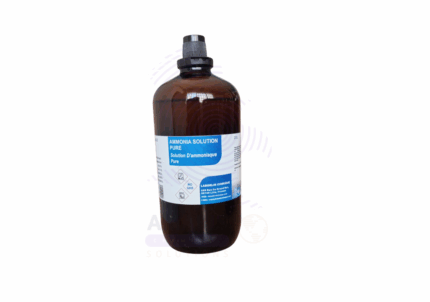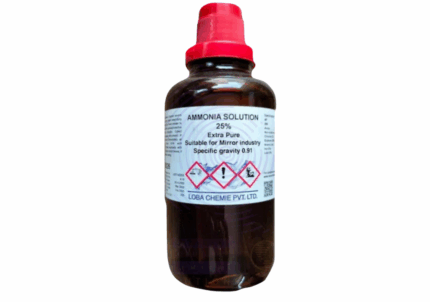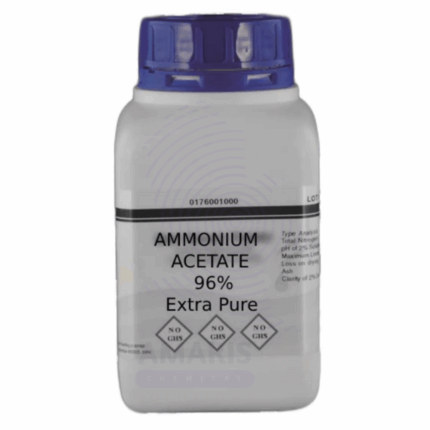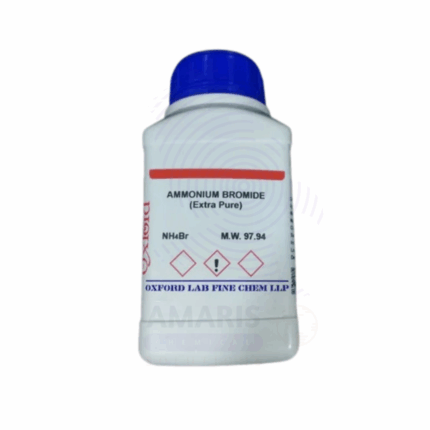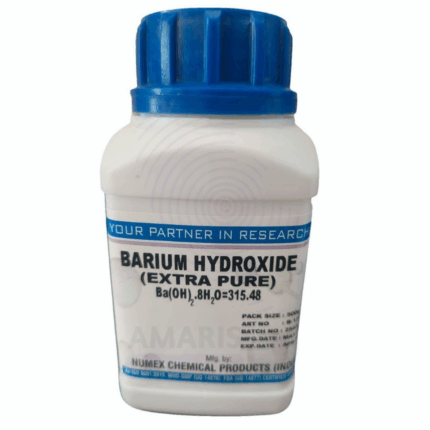
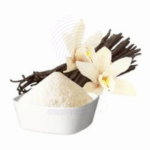
Fructose Extra Pure
$ 18.00 Original price was: $ 18.00.$ 17.83Current price is: $ 17.83.
Fructose Extra Pure is a high-purity, naturally occurring monosaccharide renowned for its intense sweetness and excellent solubility. Widely used in laboratory research, food analysis, and pharmaceutical formulations, it serves as a key carbohydrate reference and energy source in various biochemical applications. Its high reactivity and compatibility with a range of analytical techniques make it ideal for testing and formulation development in nutritional science, fermentation processes, and metabolic studies. The extra pure grade ensures minimal interference from impurities, making it suitable for precision-sensitive environments.
Fructose Extra Pure
Primary Uses
- Biochemical research:
Used as a substrate in metabolic and enzymatic studies, especially in glycolysis and carbohydrate metabolism. - Cell culture and microbiology:
Serves as a carbon source in microbial growth media for cultivating bacteria, fungi, or yeast strains.
Secondary Uses
- Analytical chemistry and standards preparation:
Used to prepare calibration standards or controls in sugar analysis via chromatography or spectrophotometry. - Osmotic agent in plant physiology studies:
Applied to create osmotic stress or control water potential in plant cell or tissue culture experiments. - Food and pharmaceutical simulation studies:
Utilized in simulation of natural matrices for testing preservatives, stability, or degradation of formulations.
| PACK SIZE |
500 grams Plastic Tin |
|---|
1. Basic Identification Attributes
- Chemical Name: Fructose
- Other Names: Fruit sugar, D-fructose, Levulose
- Chemical Formula: C₆H₁₂O₆
- CAS Number: 57-48-7
- Molecular Weight: 180.16 g/mol
- Grade: Extra Pure (Laboratory Reagent Grade)
- Appearance: White crystalline powder
- Odor: Odorless
- Taste: Intensely sweet
2. Physical & Chemical Properties
- Melting Point: ~103–105 °C (decomposes)
- Solubility: Soluble in water, sparingly soluble in alcohol
- Optical Activity: Levorotatory
- Stability: Stable under normal lab conditions
- Hygroscopic: Yes (absorbs moisture from air)
- pH (1% solution): ~5.5–7
3. Safety & Hazard Attributes
- Hazard Classification: Not hazardous under normal lab use
- GHS Symbols: None required
- Hazard Statements:
- Generally considered safe (GRAS)
- May cause mild irritation to eyes or respiratory tract in large quantities
- PPE Requirements:
- Standard lab coat and gloves
- Safety glasses if airborne dust is present
- Dust mask for handling large volumes or powders
- First Aid Measures:
- Inhalation: Move to fresh air; seek medical advice if irritation persists
- Skin Contact: Wash with water
- Eye Contact: Rinse thoroughly with water
- Ingestion: Non-toxic; rinse mouth if large amounts ingested
4. Storage & Handling Attributes
- Storage Conditions:
- Store in a tightly closed container in a cool, dry place
- Protect from moisture and direct sunlight
- Hygroscopic: Use desiccator if possible
- Handling Notes:
- Avoid generation of dust
- Wash hands after handling
- Keep away from strong oxidizers
5. Regulatory & Compliance Attributes
- Food Grade Status: Often overlaps with food grade for non-lab uses
- Regulatory Notes:
- Listed in pharmacopeias and food safety databases
- GRAS (Generally Recognized As Safe) by FDA
- Not classified as hazardous under GHS
6. Laboratory Applications
- Primary Uses:
- Reagent in carbohydrate and sugar-related studies
- Control in sugar fermentation and metabolism experiments
- Used in biochemical and enzymatic assays
- Nutrient/carbon source in microbiological media
- Secondary Uses:
- Sweetener in food and beverage R&D
- Pharmaceutical excipient or formulation aid
- Model compound for studies on glycation, browning, or antioxidant tests
SAFETY PRECAUTIONS
Personal Protective Equipment (PPE):
- Wear lab coat, nitrile gloves, and safety goggles.
- Use a dust mask if handling powder in bulk to avoid inhalation.
Handling:
- Avoid generating or inhaling dust.
- Prevent contact with eyes and skin.
- Wash thoroughly after handling.
- Use only with adequate ventilation.
Storage:
- Store in a cool, dry, well-ventilated area.
- Keep container tightly closed.
- Protect from moisture and direct sunlight.
- Store away from strong oxidizers.
FIRST AID MEASURES
Inhalation:
- Move person to fresh air.
- Seek medical attention if symptoms such as coughing or difficulty breathing occur.
Skin Contact:
- Wash affected area with soap and water.
- Remove contaminated clothing.
- Seek medical advice if irritation develops.
Eye Contact:
- Rinse cautiously with water for several minutes.
- Remove contact lenses if present and easy to do.
- Continue rinsing and seek medical attention if irritation persists.
Ingestion:
- Rinse mouth with water.
- Not expected to be hazardous in small quantities, but seek medical advice if symptoms occur.
FIRE FIGHTING MEASURES
Flammability:
- Not classified as flammable, but fine dust can pose a combustible dust hazard.
- May form explosive dust-air mixtures in confined spaces.
Extinguishing Media:
- Use water spray, dry chemical, CO₂, or foam.
- Avoid using a strong water jet that may spread dust.
Hazardous Combustion Products:
- May produce carbon monoxide (CO) and carbon dioxide (CO₂) when burned.
Firefighter Protection:
- Use self-contained breathing apparatus (SCBA) and full protective gear.
- Avoid inhalation of smoke and combustion byproducts.


 Preservatives(food)
Preservatives(food) Flavor Enhancers
Flavor Enhancers Acidulants
Acidulants Sweeteners
Sweeteners Antioxidants
Antioxidants Colorants(food)
Colorants(food) Nutraceutical Ingredients (food)
Nutraceutical Ingredients (food) Nutrient Supplements
Nutrient Supplements Emulsifiers
Emulsifiers
 Collectors
Collectors Dust Suppressants
Dust Suppressants Explosives and Blasting Agents
Explosives and Blasting Agents Flocculants and Coagulants
Flocculants and Coagulants Frothers
Frothers Leaching Agents
Leaching Agents pH Modifiers
pH Modifiers Precious Metal Extraction Agents
Precious Metal Extraction Agents
 Antioxidants(plastic)
Antioxidants(plastic) Colorants (Pigments, Dyes)
Colorants (Pigments, Dyes) Fillers and Reinforcements
Fillers and Reinforcements Flame Retardants
Flame Retardants Monomers
Monomers Plasticizers
Plasticizers Polymerization Initiators
Polymerization Initiators Stabilizers (UV, Heat)
Stabilizers (UV, Heat)
 Antifoaming Agents
Antifoaming Agents Chelating Agents
Chelating Agents Coagulants and Flocculants
Coagulants and Flocculants Corrosion Inhibitors
Corrosion Inhibitors Disinfectants and Biocides
Disinfectants and Biocides Oxidizing Agents
Oxidizing Agents pH Adjusters
pH Adjusters Scale Inhibitors( water)
Scale Inhibitors( water)
 Antioxidants(cosmetic)
Antioxidants(cosmetic) Emollients
Emollients Fragrances and Essential Oils
Fragrances and Essential Oils Humectants
Humectants Preservatives
Preservatives Surfactants(cosmetic)
Surfactants(cosmetic) Thickeners
Thickeners UV Filters
UV Filters
 Fertilizers
Fertilizers Soil Conditioners
Soil Conditioners Plant Growth Regulators
Plant Growth Regulators Animal Feed Additives
Animal Feed Additives Biostimulants
Biostimulants Pesticides (Herbicides, Insecticides, Fungicides)
Pesticides (Herbicides, Insecticides, Fungicides)
 Active Pharmaceutical Ingredients (APIs)
Active Pharmaceutical Ingredients (APIs) Excipients
Excipients Solvents(pharmaceutical)
Solvents(pharmaceutical) Antibiotics
Antibiotics Antiseptics and Disinfectants
Antiseptics and Disinfectants Vaccine Adjuvants
Vaccine Adjuvants Nutraceutical Ingredients (pharmaceutical)
Nutraceutical Ingredients (pharmaceutical) Analgesics & Antipyretics
Analgesics & Antipyretics
 Analytical Reagents
Analytical Reagents Solvents(lab)
Solvents(lab) Chromatography Chemicals
Chromatography Chemicals Spectroscopy Reagents
Spectroscopy Reagents microbiology-and-cell-culture-reagents
microbiology-and-cell-culture-reagents Molecular Biology Reagents
Molecular Biology Reagents Biochemical Reagents
Biochemical Reagents Inorganic and Organic Standards
Inorganic and Organic Standards Laboratory Safety Chemicals
Laboratory Safety Chemicals Specialty Laboratory Chemicals(Special Laboratory Equipment)
Specialty Laboratory Chemicals(Special Laboratory Equipment)
 Demulsifiers
Demulsifiers Hydraulic Fracturing Fluids
Hydraulic Fracturing Fluids Scale Inhibitors(oil)
Scale Inhibitors(oil) Surfactants(oil)
Surfactants(oil) Drilling Fluids
Drilling Fluids
 Dyes and Pigments
Dyes and Pigments Bleaching Agents
Bleaching Agents Softening Agents
Softening Agents Finishing Agents
Finishing Agents Antistatic Agents
Antistatic Agents
 Admixtures
Admixtures Waterproofing Agents
Waterproofing Agents Sealants and Adhesives
Sealants and Adhesives Curing Compounds
Curing Compounds Concrete Repair Chemicals
Concrete Repair Chemicals Anti-Corrosion Coatings
Anti-Corrosion Coatings
 Surfactants(cleaning)
Surfactants(cleaning) Builders
Builders Enzymes
Enzymes Solvents (Cleaning)
Solvents (Cleaning) Fragrances
Fragrances
 Electronic Chemicals
Electronic Chemicals Catalysts
Catalysts Lubricants
Lubricants Photographic Chemicals
Photographic Chemicals Refrigerants
Refrigerants Automotive chemicals
Automotive chemicals Pyrotechnic Chemicals
Pyrotechnic Chemicals
 Biodegradable Surfactants
Biodegradable Surfactants Bio-based Solvents
Bio-based Solvents Renewable Polymers
Renewable Polymers Carbon Capture Chemicals
Carbon Capture Chemicals Wastewater Treatment Chemicals
Wastewater Treatment Chemicals
 Pigments
Pigments Solvents(paint)
Solvents(paint) Specialty Coatings
Specialty Coatings Binders/Resins
Binders/Resins Additives
Additives Driers
Driers Anti-Corrosion Agents
Anti-Corrosion Agents Functional Coatings
Functional Coatings Application-Specific Coatings
Application-Specific Coatings
 Fresh Herbs
Fresh Herbs Ground Spices
Ground Spices Whole Spices
Whole Spices Spice Blends
Spice Blends Dried Herbs
Dried Herbs
 Leavening Agents
Leavening Agents Dough Conditioners
Dough Conditioners Flour Treatments
Flour Treatments Fat Replacers
Fat Replacers Decoratives
Decoratives Preservatives(baking)
Preservatives(baking)
 Plasticizers & Softeners
Plasticizers & Softeners Reinforcing Agents
Reinforcing Agents Adhesion Promoters
Adhesion Promoters Vulcanizing Agents
Vulcanizing Agents Antidegradants
Antidegradants Blowing Agents
Blowing Agents Fillers & Extenders
Fillers & Extenders Accelerators & Retarders
Accelerators & Retarders

